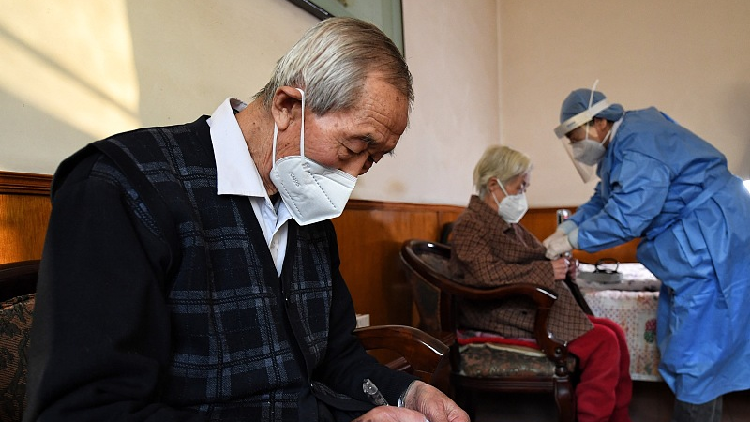Is it time for another COVID booster shot? Health officials aren’t sure – San Francisco Chronicle


People who received the bivalent COVID-19 booster when it first became available more than six months ago may wonder whether it’s time to roll up their sleeves again. The mantra of public health officials throughout the pandemic has been for individuals to maintain their immunity levels by staying up to date on vaccinations.
But no one seems to know what happens next.
The bivalent boosters were engineered to guard against the original coronavirus strain and recent BA.4/5 omicron subvariants. Even with a batch of recent studies showing that the protection they afford wanes after a few months, there is no apparent timeline for the next round of shots in the U.S.
To the contrary, the U.S. Centers for Disease Control and Prevention is so far standing firm on its recommendation for only one bivalent booster shot for all Americans. Unlike health authorities in some other countries, the agency has offered only vague clues about what’s ahead in the fight against the SARS-CoV-2 coronavirus.
Advisers to the CDC suggested last month that based on available evidence, older people and those with weakened immune systems will likely require a single COVID-19 shot once a year, probably in the fall. They made no new recommendations for most adults and children, nor have they said anything about shots between now and then.
Dr. Eric Topol of Scripps Research called the ambiguity a “problem.”
It’s “troubling for people who never had COVID and are at an advanced age, that there’s no plan until next fall to do something about it,” Topol told Dr. Bob Wachter, UCSF’s chief of medicine, in a webinar last week.
So far the coronavirus has shown no distinctive seasonal pattern, although that may be changing with more recent subvariants and as immunity levels have risen in society as a whole. Unlike flu, which circulates in the U.S. during late fall and winter, COVID-19 waves have occurred year-round until now.
Last March, before the rollout of the bivalent boosters, the CDC recommended that those who were immunocompromised or over age 50 receive an updated shot four months after their previous dose.
While more than 81% of the U.S. population has had at least one vaccine dose, only 16.2% of those eligible — roughly 53.6 million people — have received the latest boosters authorized in August. In California, about 25% of residents have received the bivalent dose. Millions more around the country haven’t had a booster for a year or more.
“Because of lack of demand, it’s all coalescing around the seasonal push,” said Peter Chin-Hong, an infectious disease doctor at UCSF.
That’s still a considerable number of people left wondering what to do. In a recent survey by the Kaiser Family Foundation, 15% of all adults, or more than 38 million Americans, said they are waiting on guidance about getting another booster.
The initial shots from Pfizer and Moderna — called the primary series — target the strain of the virus that first emerged in 2020. The updated boosters launched last fall were tweaked to target omicron relatives that had been dominant.
Federal health officials say that many Americans now have sufficient preexisting immunity against the coronavirus because of vaccination, infection or a combination. The CDC and the U.S. Food and Drug Administration said in January that the baseline of protection should be enough to move to an annual booster against the latest strains in circulation and make COVID-19 vaccinations more like the yearly flu shot.
To Chin-Hong, that sounds like a reasonable plan.
“The immune force field is so big now and we have so many tools, hopefully, it mitigates the damage,” he said. “I think we will see bumps in cases, but hopefully we won’t see a big bump until next winter. With another shot — and my hope will be it’s timed with the flu shot.”
Ultimately, FDA officials say moving to an annual schedule would make it easier to promote future vaccination campaigns, which could ultimately boost vaccination rates nationwide.
Officials from the California Department of Public Health say they will update state guidelines based on recommendations from federal agencies.
Those who are immunocompromised or at high risk for disease — in a tough spot after the FDA last month pulled its authorization of Evusheld, a preventive monoclonal antibody treatment for COVID-19 — may consider getting a sixth shot now at their local pharmacy, said Topol.
But that’s not an official recommendation, and doctors are taking a wait-and-see attitude.
Other places are taking a more proactive stance. The U.K. this past week announced a plan to offer vulnerable people an additional COVID booster shot this spring, targeting those 75 and older and residents of care homes, plus immunocompromised people aged 5 and over. The program is intended to “bridge the gap” to a planned booster program in the fall so that the most vulnerable will have protection through the summer.
No such plan exists in the U.S.
With the national COVID-19 pandemic emergencies set to expire on May 11, federal officials say the next round of vaccines will likely hit the commercial market once the doses are reformulated to combat the next coronavirus lineage.
Experts continue to debate whether younger, healthier people would need a COVID-19 booster every year.
“Protection against hospitalizations and deaths remains pretty high,” Topol said, adding that the bivalent booster helps lift that protection level to the 85% to 90% range. “But we don’t have any data for that sixth shot. It would be nice if we had some actual evidence, and we don’t right now.”
The Associated Press contributed to this report.
Reach Aidin Vaziri: avaziri@sfchronicle.com















